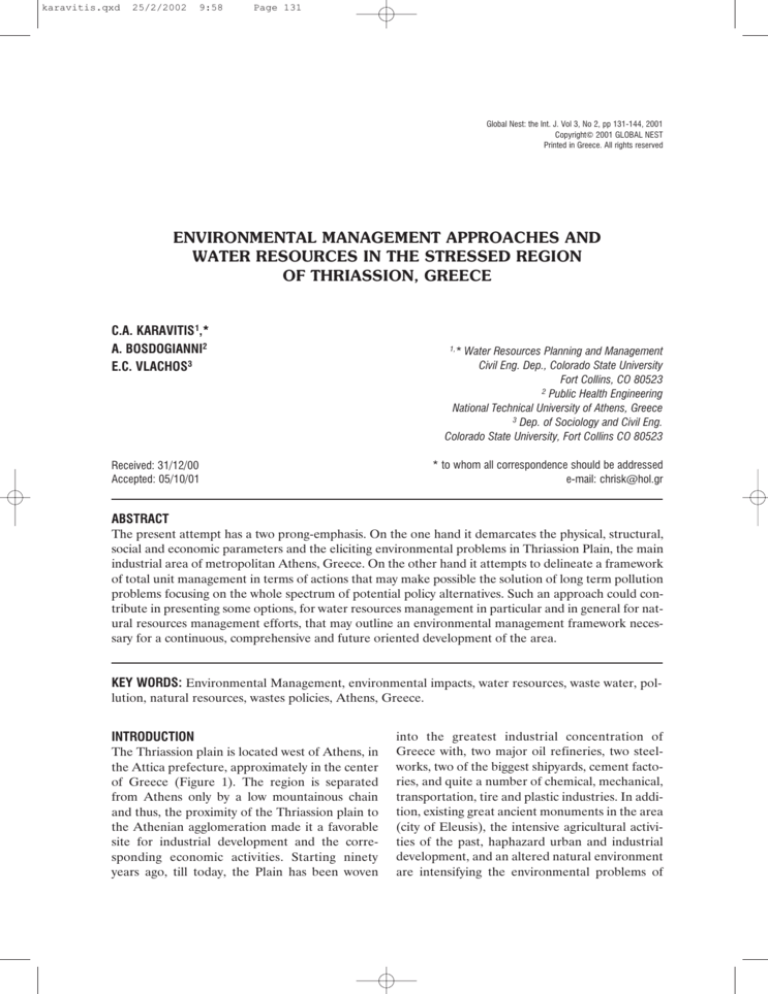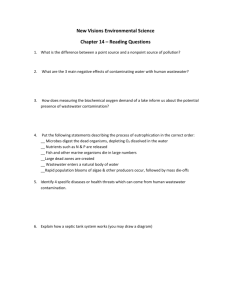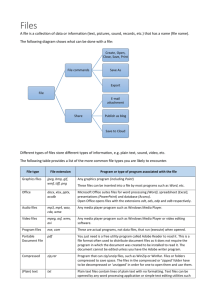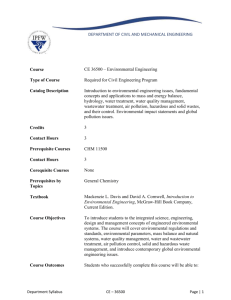
karavitis.qxd
25/2/2002
9:58
Page 131
Global Nest: the Int. J. Vol 3, No 2, pp 131-144, 2001
Copyright© 2001 GLOBAL NEST
Printed in Greece. All rights reserved
ENVIRONMENTAL MANAGEMENT APPROACHES AND
WATER RESOURCES IN THE STRESSED REGION
OF THRIASSION, GREECE
C.A. KARAVITIS1,*
A. BOSDOGIANNI2
E.C. VLACHOS3
Received: 31/12/00
Accepted: 05/10/01
1,*
Water Resources Planning and Management
Civil Eng. Dep., Colorado State University
Fort Collins, CO 80523
2 Public Health Engineering
National Technical University of Athens, Greece
3 Dep. of Sociology and Civil Eng.
Colorado State University, Fort Collins CO 80523
* to whom all correspondence should be addressed
e-mail: chrisk@hol.gr
ABSTRACT
The present attempt has a two prong-emphasis. On the one hand it demarcates the physical, structural,
social and economic parameters and the eliciting environmental problems in Thriassion Plain, the main
industrial area of metropolitan Athens, Greece. On the other hand it attempts to delineate a framework
of total unit management in terms of actions that may make possible the solution of long term pollution
problems focusing on the whole spectrum of potential policy alternatives. Such an approach could contribute in presenting some options, for water resources management in particular and in general for natural resources management efforts, that may outline an environmental management framework necessary for a continuous, comprehensive and future oriented development of the area.
KEY WORDS: Environmental Management, environmental impacts, water resources, waste water, pollution, natural resources, wastes policies, Athens, Greece.
INTRODUCTION
The Thriassion plain is located west of Athens, in
the Attica prefecture, approximately in the center
of Greece (Figure 1). The region is separated
from Athens only by a low mountainous chain
and thus, the proximity of the Thriassion plain to
the Athenian agglomeration made it a favorable
site for industrial development and the corresponding economic activities. Starting ninety
years ago, till today, the Plain has been woven
into the greatest industrial concentration of
Greece with, two major oil refineries, two steelworks, two of the biggest shipyards, cement factories, and quite a number of chemical, mechanical,
transportation, tire and plastic industries. In addition, existing great ancient monuments in the area
(city of Eleusis), the intensive agricultural activities of the past, haphazard urban and industrial
development, and an altered natural environment
are intensifying the environmental problems of
karavitis.qxd
25/2/2002
9:58
Page 132
132
KARAVITIS et al.
Figure 1. Metropolitan Athens Area and Thriassion Plain (adapted from O.E.C.D., 1983)
the Thriassion region. The plain is crossed by four
major torrents, which are often flooding (with
minimal flood control works), eliciting serious
damages. On the same time they are used as open
sewers for the industrial effluents, and hence are
greatly polluted. The over-exploitation of the
alluvial aquifer has led to sea-water intrusion
extended for kilometers away from the coast.
Overall the industrial by-products, and the
absence of any serious waste treatment efforts as
well as of timely and organized ad-hoc policies,
has polluted to a great degree the water
resources, the land and the air of the Thriassion
plain demarcating at same time the parameters of
the problem at hand. In this regard, the emphasis
in the following sections is on:
1. Presenting the data and the parameters that
delineate the Thriassion Plain as an extreme
case of land, water and air pollution. At the
same time underscoring the facts that the
Plain is at the center of a heavily urbanized
and historically significant region.
2. Showing the need for restoration and renova-
tion, a framework of approaches and actions is
described for comprehensive waste management, with a concentration in water resources
and wastewater, based on a holistic environmental management framework, thus outlining relevant solutions integrating ecosystemic
viability and the future of sustainable development.
Concluding, this research may point out the
necessity of total unit management in terms of
appropriate and reasonable actions that may
make possible the solution of long term environmental problems leading towards the long term
viability of the region.
THE CONTEXT OF THRIASSION PLAIN
The collection of material for the current effort
about the Thriassion Plain took place between
1996 to 1999. The data have been collected
through numerous visits in the area of interest in
order to delineate as close as possible, the water
and waste water infrastructure, as well as environmental, institutional and socio-economic condi-
karavitis.qxd
25/2/2002
9:58
Page 133
ENVIRONMENTAL MANAGEMENT APPROACHES AND WATER RESOURCES IN THE STRESSED REGION OF THRIASSION
tions affecting the use and misuse of resources in
the region. The data collection incorporated
material from all environmental impact assessments submitted to the relevant authorities by the
industries operating in Thriassion Plain. Such
assessments were part of the regulatory permissions required in order to control the production
of liquid and solid waste (total number 104).
Personal communication with the pertinent
authorities included the Eleusis Coast Guard, the
Western Attica Prefecture directorships of
Industry, City Planning and Public Health, the
Ministry of Development, the Company of Water
Supply and Wastewater of the Capital (EYDAP),
the Municipalities and other local authorities.
Finally, the existing law enforcement policies
were analyzed and applied penalties for effluents
standards violation were examined.
Physiography and climate
The Thriassion Plain is separated from the
Athenian one by the Aigaleo hills to the east,
while to the south opens to the bay of Eleusis
(Figure 1). To the northwest a mountainous chain
limits the plain. The region has an area of 345 km2
from which 20.6% is the cultivated land, 35.4%
are pastures, 29% are forests and only 4.4% is the
urban area. However the majority of the activities
has been concentrated near the coastal area of
the plain. This coastal part with an approximate
area of 100 km2 includes the 25 km2 of the industrial section, the 15 km2 of the urban developments and the 12 km2 of the military airport.
One of the primary road axes of Greece, as well
as primary railroad corridors of the country, is
crossing the plain. The annual load is close to 30
million vehicles. Another problem of Thriassion
is the absence of road infrastructure to support
the industrial activities and thus heavy traffic has
to cross a limited existing urban network. There
are 13 harbor facilities on the coast with an average load of 5,500 ships per year. As a result from
the 15 km of the Plain coastline the 12 km are
used by the harbor and docking complexes. In
addition 1 km2 of sea surface has been
reclaimed by the land due to the dumping of
industrial solid waste.
The climate is characterized by hot dry summers
and mild wet winters. According to the
Meteorological Station in the Eleusis Airport
(EYDAP, 1996) the average daily temperature
133
varies from 9°C in January to 29°C in July and
August. The winds are predominantly from the
North (30%) with an average between 2-4 of the
Beaufort scale. The average annual rainfall is 390
mm (values from 1950-1992). It is expected a
higher rainfall value for the upper part of the
plain, nevertheless, there is no Meteorological
station on the higher elevations to measure such
differences. For the overall basin estimates are at
about 420 mm of average annual precipitation
(Antoniou et al., 1982). The rivers that cross the
plain are ephemeral torrents, with only one small
natural lake.
Population and Industry
The region is located only 20 km west of the
Athenian conurbation, and thus it was early made
a favorite site for industrial development. A map of
the larger area has already been introduced in
Figure 1. The first industry was established on
1875, and by 1910 there were already 10 major
units (cement, wine and liquors, olive oil refineries
etc.). The first appearance for environmental pollution was recorded on 1930, due to the cement
dust byproducts. However, in the decades of 1950
and 1960 the industrial growth was becoming
almost exponential with the establishment of
National importance industries, such as the
Aspropyrgos Oil Refineries, the Petro-gas (synthetic fuel gases), Steelworks, Cement factories,
Shipyards, chemical and plastic factories. In the
following decades (1970s and 1980s) very few
major industries were established, where as the
existing ones were expanding their installations,
attracting also satellite industrial activities. By the
middle 1990s a decline in the number of industries
was recorded. Currently according to the number
of employees and the annual budget in relevant
among them numbers, there are about 1000 small
and medium size industries and about 15 large
units, situated either dispersed or at eight industrial sites (2 at Eleusis, 5 at Aspropyrgos and 1 at
Mandra). All this time uncontrolled and unauthorized dumping of industrial by-products, garbage
and non-wanted items, junkyards or automobiles
cemeteries and used tires yards have transformed
the region to a waste sink for the metropolitan
Athens area. In this regard, the Thriassion plain
became both an important and easily accessible
area for the adjacent Athenian conurbation and a
high risk environmental liability.
karavitis.qxd
25/2/2002
9:58
Page 134
134
Table 1:
KARAVITIS et al.
Population growth in Thriassion Plain (N.S.C., 1996; Company of Water Supply and Wastewater of
the Capital, 1996).
Population
Municipality
1951
1961
1971
1981
1996
2010
2030
11,200
15,500
18,500
20,300
24,700
32,800
39,700
Aspropyrgos
5,900
8,200
11,200
12,550
16,600
24,280
32,400
Mandra
3,900
5,500
8,050
8,800
12,500
20,180
29,800
450
700
1,200
1,900
3,000
5,340
7,900
21,450
29,900
38,950
43,550
56,800
82,600
109,800
Eleusis (Elefsina)
Magoula
Total
Following the rapid industrial growth in the last
30-40 years, a parallel population increase has
taken place. Table 1 presents the population
growth in Thriassion Plain and the corresponding
projections for the years 2010 and 2030.
According to the 1991 census, the total population in the four major communities was 53,000
inhabitants and in 1996 the population has
reached 56,800 inhabitants, in comparison to the
21,000 of 1951. The rate of population increase
has been declining in the decade of 1971/81 possibly due to the environmental degradation, however in the 1981/91 the establishment of new
industries (particularly chemical) and the new
job opportunities in a tough market, has led to a
new rate increase despite the pollution problems.
Nevertheless, the majority of the working force is
still living in Greater Athens. Additionally, the
changing land use from the traditional agricultural activities to the industrial developments,
housing complexes etc. resulted to corresponding
changes in the structure of the local economy and
the accompanied shifting for the working force,
from the agricultural sector to the industrial one.
The agricultural activities were traditionally concentrated on olive groves, cereals and pistachios
plantations. However the percentage of agricultural land use is continuously declining from the
recorded 20%. The reasons for such a trend may
be mainly the shift towards industrialization, and
secondary the limited irrigated area, the soil
exhaustion, the unsuitable for the region corps,
and the small size of the agricultural land properties. In this regard the value of agricultural land is
ranging from 200 USD m­2 to 1000 USD m­2
with the higher ones closer to the industrial concentrations.
Water resources
The Thriassion watershed has a total area of 480
km2, an average annual surface runoff coefficient
of 0.10 based on the average annual precipitation
of 420 mm. Thus the total annual volume of
runoff is close to 20×106 m3 (Antoniou et al.,
1982). The pertinent volume is drained through
the following ephemeral streams (Figure 2):
Sarantapotamos, with a watershed of 266 km2 is
the largest torrent in the area. It is often flooded with serious damages. The latest flood of
Jan. 1996 has cut-off the primary road and railroad arteries from Athens to Corinth.
Saint George (Giannoulas) having a catchment
of 110 km2. It is often flooded and it is also
exhibiting major environmental problems since
it receives a significant amount of effluents
from the nearby industries.
Soures, with a watershed of 50 km2. It is often
flooded with serious damages on the western
part of the plain.
Saint John, which is having a 32 km2 watershed
mostly in low elevation areas, with some flood
problems in the past.
The torrents of Maure Hora and Diylisteria are
forming mainly on the lower plain with watersheds of 23 km2 and 12 km2 correspondingly.
Flood and floodplain protection works are missing except from a few minimal or inefficiently
designed schemes in some of the torrents. The
majority of the precipitation falls during the win-
karavitis.qxd
25/2/2002
9:58
Page 135
ENVIRONMENTAL MANAGEMENT APPROACHES AND WATER RESOURCES IN THE STRESSED REGION OF THRIASSION
135
Figure 2. Main torrents in Thriassion Plain (adapted from EYDAP, 1996).
ter months creating also flush floods, whereas the
summer period is extremely dry. Erosion problems are also present compounding to the flood
impacts. As an indication, it is estimated that a
medium range flood (50 yr return period) of the
St. George torrent would cause damages close to
200 millions U.S.D. to the adjacent EL.D.A. oil
refineries, apart from the other impacts
(Karavitis, 1999b). On May 1999, plans for flood
protection works were in the phase of final study.
The plain had also two natural lakes, the Reiton
lakes, an important part in the festivities of
Eleusinian Mysteries in ancient times. The
smaller lake has been drained in 1950s, and now
it is a part of the EL.D.A. oil refineries entrance
area. The second lake survived, but it is seriously
polluted by oil from the adjacent military unit and
through infiltration from the EL.D.A. area. The
overspill of the lake is drained to the sea compounding to the pollution problems.
Geologically, the higher elevations are limestones
(mainly biosparudites) and dolomites of Triassiclower Jurassic age, interbeded with limestones of
lower-middle Triassic. The plain consists of alluvial deposits, alluvial fans and older talus cones
(Holocene age) and conglomerates. Limestones
(biomicrudites, biosparudites and biomicrites) of
Cenomanian Maestrichtian age are also present.
Such geological formations exhibit low values of
runoff coefficients and high infiltration rates to
the underlining aquifers.
The main aquifers are forming in the plain conglomerates and limestones. The average annual
withdrawals are close to 9 ×106 m3 and the annual
rate of the ground water surface decline is about
0.25 m. The depth of the groundwater surface is
fluctuating from 30 m to 100 m and the withdrawal rate was recorded between 5-70 m3 h­1. It is estimated that more than 4000 wells and boreholes are
concentrated in the coastal area of the plain (100
km2 area) with a 35% increase the last 22 years and
used mainly for industrial purposes (Bosdogianni,
1997). The sea-water intrusion has reached a front
8-10 km away from the coast-line (Kounis, 1986).
The groundwater has been also seriously polluted
by heavy metals, nitrates and chloron. Agriculture
and industry by dumping untreated their effluents,
are mainly responsible for such a pollution. In
addition, the unlined solid waste burial site for
Metropolitan Athens to the east of the region (Nea
Liossia-Aspropyrgos) with 1 million tn yr-1 of
municipal wastes and 23,000 tn yr-1 of toxic wastes
is another source of polluted leachates to the
Thriassion Plain aquifers (Bosdogianni, 1997).
Eleusis bay
The major pollution sources for the Eleusis bay
are the local industries, the wastewater of the
karavitis.qxd
25/2/2002
9:58
Page 136
136
Athens Metropolitan area of which 20% is entering the bay, by the eastern sound, and the ships,
the shipping industry and related activities.
The Eleusis bay has an average depth of 18 m,
with a maximum one of 33 m. The surface area of
the bay is 67 km2 and its water volume 1.2×109 m3.
The bay communicates with Saronicos gulf
through Keratsini (Piraeus) sound to the east, and
Megara sound to the west (Figure 1). Keratsini
sound has a maximum depth of 12 m and a width
of 1.2 km on the surface and 250 m in the bottom,
whereas Megara sound has a depth of 8 m and a
width of 600 m and 170 m correspondingly. The
prevailing summer current is from east to the west
with a rate of 450 m3 sec-1. The average renewal
time is 2-3 months and the bay exhibits a high
salinity concentration in the summer
(Abatzoglou, 1987; Catsiki, 1991). Thus, the bay
is extremely vulnerable to pollution.
The main pollution source of Elefsis bay is the
industrial wastewater of the Greater Athens area,
20% of which was discharged until recently
through the west opening to the bay and the seepage activities. The industry pollutes with both
wastewater and solid wastes, which are gradually
deposited to the sea-bottom. The Athenian
wastewater carries dissolved and suspended
material, which is also gradually deposited.
Finally, the ship industry pollutes through oil
products (ship-building, refueling, etc.), metallic
by-products, paints and other chemicals as the
second biggest Greek shipyard (one of the biggest
in Europe) is located at the eastern part of Eleusis
bay. Furthermore, there are one smaller shipyard
and six ship demolishing units. The two shipyards
are producing about 700 tn yr-1 of sludge, which
presumably are being dumped in the Athens landfill. The bay is also being used as a harbor for noncommissioned ships with a total number of about
450 vessels, almost double the areas capacity,
thus creating another source of pollution. As a
result, severe pollution and eutrophication are
present in the bay, and the authorities have prohibited swimming and other recreational activities (Friligos, 1987). Pollution prevention measures were not being reported (Abatzoglou,
1987).
According to measurements made by the
Pollution Control Center of Eleusis Municipality
(EYDAP, 1996), covering the period 1984-1995,
the turbidity at the center of the bay varying
KARAVITIS et al.
between 1.5-8 m. The salinity appeared to be
decreased near the offshore due to the discharge
of the torrents. The prevailing pollutants are the
nutrients due to municipal waste waters, PO4-P
with concentrations varying between 3-18 mg l-1,
NO2-N (0.07-6.20 mg l-1), NO3-N (0.20-2.20 mg l­1)
and SiO4-Si due to industrial waste and seepage activities. Furthermore the heavy metals as
Cu, Cd, Zn, Pb, Fe, Cr, Ni with concentrations
varying between 2-3.5 ìg l­1, 1-2 ìg l­1, 10-80 ìg l­1,
10-30 ìg l­1, 1-40 ìg l­1, 2-20 ìg l­1, 1-13 ìg l­1
approximately. DO concentrations deeper than
15 m were practical equal to zero during the summer months, due to stratification. Anoxic conditions prevail until November. A vertical thermal
structure develops during March to October,
though during the winter months a vertical water
mixing and uniformity is noticed. DO concentrations varying between 4-14 mg l­1 throughout all
the depth during November to March. However
the water quality seems to be improved since
1985, as DO concentrations sustain at adequate
level throughout all the year (Abatzoglou, 1987;
Catsiki, 1991; EYDAP, 1996).
WATER RESOURCES MANAGEMENT ISSUES
Water resources management context and
water supply
In trying to outline measures for responding to
the series of severe water quality problems in the
Thriassion area it is important to understand the
broader context Greek water resources management. The most pressing issue is the fact that
there are many government departments dealing
with water problems, but their activities are compartmentalized and not well-coordinated. Added
to this is a water law system which is not responsive to modern issues of an industrial society and
widely scattered, thus permitting overlapping
functions, multiple advisory bodies and insufficiently decentralized management responsibilities through regional organizations. The law tends
to be also deficient in the case of pollution issues,
where quality standards for water bodies and/or
effluent have not been clearly established.
Furthermore, the sporadic consideration of water
quality issues in a coherent water policy and the
absence of systematic, uniform and enforceable
pollution charges have compounded problems
and have handicapped the water resources management efforts (Dalacu, 1998).
karavitis.qxd
25/2/2002
9:58
Page 137
ENVIRONMENTAL MANAGEMENT APPROACHES AND WATER RESOURCES IN THE STRESSED REGION OF THRIASSION
The Attica sector, which includes Thriassion, is
the only one of the 14 water sectors in Greece
where urban-industrial water consumption
exceeds by far any other uses. The responsibility
for the water supply and the wastewater of the
Athens region belongs to the Company of Water
Supply and Wastewater of the Capital (EYDAP).
According to the existing legislation EYDAP is
solely responsible for water supply and wastewater works to perform studies, construction,
maintenance, repair, operation, financing, revenue, etc. However, for flood protection and pollution control works the Ministry of Environment,
City Planning and Public Works (YPEXODE)
has the responsibility of studies and construction,
whereas EYDAP executes the remaining functions. The budget of EYDAP is supervised by the
Ministry of Economics (Karavitis, 1999a). Thus,
the unsystematic and duplicating efforts for coordinated water and water infrastructure management.
The haphazard urban development in the recent
decades has been compounded by an almost total
absence of city planning, by the serious environmental deterioration resulting from industries
build in the sea front or even inside the archaeological sites (ancient theatre and stadium). In this
context, the water supply system had to follow
already existing routes with the corresponding
problems and losses up to 30 % (Karavitis,
1999a). The urban water consumption, including
losses in the water supply system, was about
12.5×106 m3 in 1995 provided by EYDAP. In the
same year, the per capita consumption was estimated at 170 l inh­1 day­1 without losses. It is forecasted that by 2030 the per capita consumption
would reach 235 l inh­1 day­1 (EYDAP, 1996). The
industrial water consumption cannot be safely
estimated, since the industries are consuming
mainly groundwater and sea water mostly for
the cooling process. Indirectly, it may be
derived, that the industrial water consumption
from the pertinent sources would be at the range
of 50×106 m3 yr ­1 taking into account the total
amount of effluents.
Wastewater issues
In Thriassion, as well as in the whole country,
wastewater and wastewater systems have been
treated incrementally without the requisite
comprehensive planning. Currently, the region is
137
lacking both a wastewater and a stormwater collection system. The urban area is being serviced
by septic tanks, which are polluting the aquifers
through seepage and by over spilling to the surface. Plans for the construction of stormwater and
wastewater systems are in the phase of final
design studies. The urban wastewater load was
8,200 m3 day­1 in 1996 and it was estimated to
reach 22,000 m3 day­1 by 2030. For the industrial
wastewater in 1985, a daily volume of 141,000 m3
(including cooling water) was damped untreated
in Thriassion plain and Eleusis bay, with a load of
1.7 tn BOD5 day­1, 1.3 tn N day­1, 0.09 tn P day­1
and 0.46 tn day­1 of oils. From this volume 1700
m3 day­1 were arriving in the bay through Saint
George torrent. In 1996, the daily hydraulic load
of only the four major industries was about
125,000 m3 day­1, whereas that one of the approximately remaining 100 industries has been estimated at around 2900 m3 day­1 (Abatzoglou,
1987; Stamatiadis, 1993).
LONG-RANGE EVALUATION
OF ENVIRONMENTAL MANAGEMENT
APPROACHES IN THRIASSION PLAIN
Sustainable Environmental Management
Interfaces in Thriassion Plain
All the previous sections have emphasized the
centrality and far-reaching consequences of waste
in modern life as well as in the case of an industrialized region such as the Thriassion Plain. The
historical data all over the planet have pointed
out to vast amounts of waste generated and to discrepancies between their generation and disposal.
The key challenge in all localities is that while
indiscriminate disposal may be a comparatively
inconsequential problem when the pollution and
industrial production are small, it becomes a different story for industrial production characterizing megalopolitan and industrialized concentrations in many countries.
Thus, waste disposal has been elevated today into
a major problem and part of a broader environmental pollution challenge. The last twenty years
have not only increased the visibility of waste but
have also produced demands for more complex
socio-economic responses to what used to be considered a simple technological challenge. The
environmental, economic and sociological dimensions of the problem and long range-emphasis
have thus become central considerations.
karavitis.qxd
25/2/2002
9:58
Page 138
138
In this regard, there are basically four options
available to control pollution resulting from the
generation of wastes (Vlachos, 1992):
1. improve the assimilative capacity of the environment;
2. change time and place of discharges in order
to take advantage of locations with better
assimilative capacity;
3. change the form of waste residuals;
4. reduce the total volume of waste discharges.
At the same time there are three basic strategies
for dealing with waste and, developing a more integrated waste management policy (Grigg,
1986). For solid waste, by far, the most common
and cheapest disposal mechanism is the sanitary
landfill (secondary are the incineration systems).
However, the use of sanitary landfill systems will
continue to depend on suitable space, transportation costs, environmental consequences and public acceptance. For wastewater, a wastewater collection system and a treatment plant are the principal tools of wastewater disposal and management. The third and complimentary alternative for
waste disposal is recycling. The advantages for such
an approach are not only the obvious economic
benefits but also the ultimate significant reduction
in materials flow, the conservation of resources for
future use and the attendant environmental benefits. Yet, these three strategic alternatives for
waste disposal are not independent of each other.
For example, increases in recycling help reduce
volumes of material going to landfills and to
wastewater systems. However, landfills and wastewater treatment systems remain also the most
acceptable disposal method for the Thriassion
Plain. But here is the next challenge: what is
apparent necessity engenders the biggest controversy, especially because of public perception.
Behind all these remarks as to waste and social
responses lie the facts of the increasing stream of
waste as a result of technology, affluence, population and shifting cultural values. Thriassion Plain
and the whole Attica region have become part of
a vast megalopolitan expansion due to historical
conditions, lack of coherent planning, and the exigencies of political compromises. The dramatic
recent growth of Greater Athens and the urban
sprawl in Attica intensify many problems inherent
in the environmental and economic structure of
the region. All relevant data point out to the
tremendous centrifugal movement from the cen-
KARAVITIS et al.
ter and the suburban expansion with a 24.5%
increase rate throughout the Attica plain
(Karavitis, 1999a). More important, since the
1980s due to both European Union developments
as well as local concerns, environmental considerations become central in the life of the region and
part of efforts for accounting for long-range
impacts and consequences.
The challenge of waste disposal (in all forms and
sources) of the Thriassion region is parallel to the
waste disposal in many parts of the planet.
Beginning from groundwater pollution and noise
pollution it may be particularly emphasized the
aesthetical or visual pollution associated with
waste and with the larger problems of public
health and ecological vulnerability of the region.
In this regard, the Thriassion Plain offers a
unique opportunity in studying water resources
and environmental management as a succinct
case of haphazard development, resources overexpoitation and serious pollution problems. The
area provides an unusual combination of unfavorable conditions such as:
absence of infrastructure;
lack of historical knowledge of the waste
stream or budget;
lack of institutional support and mobilization;
non-involvement of the public;
absence of planning and capital investments;
overexploitation of water resources in a region
of limited resilience;
lack of environmental consciousness in a fragile environment.
Hence, the challenge of resources, and effluent
control, in the Triassion Plain may be formulated
by considering some broader questions, namely
key policies that outline the problem of waste as
part of a comprehensive, systemic long-range
strategy of waste management.
Towards holistic waste management
The most pressing issue in Thriassion Plain regarding wastewater problems is the immediate design,
construction and operation of a wastewater collection system for the municipalities and the industrial sector, as well as the corresponding wastewater
treatment plant. Such projects are already under
way by the authorities. Provision is made for the
construction of the sewerage system and the Waste
Water Treatment Plant (WWTP), which will serve
the urban, rural and the industrial areas of
karavitis.qxd
25/2/2002
9:58
Page 139
ENVIRONMENTAL MANAGEMENT APPROACHES AND WATER RESOURCES IN THE STRESSED REGION OF THRIASSION
Table 2.
139
Estimated mean waste water flows in Triassion Plain (m3 d­1)
Wastes
1996
2010
2030
Municipal wastes
8,200
14,000
22,000
Industrial wastes
2,300
4,400
12,500
700
2,400
2,500
3,100
4,200
5,000
14,300
25,000
42,000
Special wastes (one hospital and two military camps)
Infiltration
Total
Thriassion Plain. The design of the treatment and
sewage system is briefly outlined below.
To start with, the liquid industrial waste characterised as toxic, explosive, flammable or caustic
materials, as well as those containing substances
which might inherent the biological activity (acids,
non ferrous metals, oils, pesticides) would not be
accepted to the sewerage system or to the WWTP.
Another restrictive design parameter would be the
higher investment cost due to the increased volume of wastes. Hence the liquid wastes from the
two main petroleum refineries of the area, the
lubase regeneration and the blowing asphalt
plants, the metal plating, the accumulators, the
paint and agrochemical industries and the tanneries would not be connected to the sewerage system. All the pertinent industries should take the
necessary measures to achieve maximum possible
reduction of hydraulic and pollution loads at the
source with the conversion of the process technology or without such a procedure (cooling water
recycling, material reuse, metal recovery, evaporation of bath water), as well as by pretreating their
waste water. After the inplant pre-treatment, further treatment of toxic liquid wastes and sludge is
planned to take place in the central treatment
plant for toxic wastes, which would be a common
one for the Attica and Boiotia Prefectures. The
present toxic load is estimated at 600 m3 day­1.
However, these plans have not yet been realised as
even the decision about the location of the pertinent plant is still pending (May, 1999).
Paper, dye-finishing, the olive oil and the food
industries by-products would be connected to the
sewerage and treatment system after pre-treatment, in order to reduce the pollution loads and
comply with the effluent standards set by the
Prefectural Decision (1979). Currently, such
wastes are estimated at about 2,300 m3 d­1.
The estimated mean wastewater flows and the
corresponding projections for the years 2010 and
2030 in m3 d­1 that would be treated in the plant
are presented in Table 2.
The Eleusis Bay will receive the treated effluents
from the WWTP through a submerged conduit.
This bay is characterised as highly eutrophic.
Hence it is recommended to be considered as a
sensitive receiving body according to the EE
Directive 91/271, which sets minimum standards
for disposal of sewage to sensitive areas. As a consequence and in order to comply with the terms of
the above mention Directive on the treatment of
the waste water, the treated effluent quality
should be: BOD5=15 mg l­1, COD=100 mg l­1,
SS=10 mg l­1, TP=1 mg l­1, TN=10 mg l­1, 5001000 FC 100 ml­1. To achieve such a quality standard the waste water treatment plant should
include the following units: pre-treatment
(screening, sand removal), primary sedimentation, activated sludge, including nitrification-denitrification, chemical phosphorus removal, secondary sedimentation, polishing and UV disinfection as well as mechanical thickening, anaerobic
digestion and dewatering of produced sewage
sludge. Already such provisions have been incorporated to its design.
The management and disposal of the dewatered
sludge, which is estimated to be 9,500 m3 y­1 (year
2010) and 19,000 m3 y­1 (year 2030), would be a
part of the whole management of sewage sludge
produced in Attica Prefecture. Namely if it would
not contain heavy metals it should be disposed to
the solid waste composting plant currently constructed at the boundaries of Thriassion Plain. In
the case of high heavy metals concentration content, it should be disposed to the heat-drying unit
karavitis.qxd
25/2/2002
9:58
Page 140
140
KARAVITIS et al.
Table 3.
Evaluation of the context of Thriassion plain.
Resources and
Infrastructure
Limited and fragile
resources,
Topographic and city
planning limitations,
Haphazard and inefficiently maintained
water infrastructure,
Lack of waste water
infrastructure.
Data domain
Abundance
of information,
Some collection
problems,
Lack of information
technologies
application in data
availability
of the dewatered sludge at Psyttalia island Waste
Water Treatment Plant serving the Metropolitan
Athens area, following the final disposal of dry
sludge as fuel.
The treated effluent volume which is estimated to
be 25,000 m3 d­1 (year 2010) should be used for
agricultural and landscape irrigation. Another
major use of reclaimed municipal wastewater
should be in the high water consumption industries of Thriassion Plain, primarily as cooling
water or at the process needs. These industries
apart from the large sea water volume consumed
at open circuits, they also use 14,000 m3 d­1
ground water as well as 5,000 m3 d­1 potable
water. The replacement of the ground water volume by the reclaimed water would be of primary
importance. In this regard, the over-exploited
aquifers should start to recover. However, a comprehensive waste management approach should
include some additional elements, apart from the
pertinent obvious engineering ones. In this context, encompassing the specific technical steps are
the following supplementary cultural and economic approaches such as:
systems of monitoring and evaluation
cultural awareness of the larger problem of
waste production and disposal;
the social structure and institutions that tend to
be conducive to comprehensive management;
the appropriate legal mechanisms and regulatory frameworks;
citizen mobilization in terms of awareness and
public participation;
Organizational
framework
Lack of effective
coordination,
Lack of local
authorities
integration and
public participation,
Partial responses,
Fragmentation of
water and waste
water management
Policy
Lack of effective systems of monitoring
and evaluation,
Centralized decision
making,
lagging enforcement,
Crisis management
(floods, pollution
control)
Tendency towards
technical solutions
proper training and environmental education
as to societys discards;
financial incentives, especially for treatment
recycling and reuse; and,
grassroots and community initiatives for innovative schemes of confronting the problem of
waste.
emphasize the culture of sustainability and the
dilemma that affluence leads to effluents.
Based on the previous discussion, the context of
Thriassion Plain with regard to a more comprehensive evaluation should be a more complex
interaction of the categories of elements outlined
in Table 3.
In an effort to summarize the above list of concerns, conflicts and crises linking sustainable
development and integrated environmental management the following interacting issues may be
demarcated in relation also to some more extensive comments on such crises made by Vlachos
and Braga (2001):
A water supply and demand crisis that represents a predominantly engineering dimension.
Management and pollution control issues
should be included such as the promotion of
more desirable levels and patterns of use of the
resources; augmenting fresh water supplies
through e.g. conservation, reuse, conjunctive
water use, etc.
A deteriorating environmental quality crisis
that can be translated into an ecological dimension of urban pollution problems. A variety of
health issues may be encounter, poor water, air
karavitis.qxd
25/2/2002
9:58
Page 141
ENVIRONMENTAL MANAGEMENT APPROACHES AND WATER RESOURCES IN THE STRESSED REGION OF THRIASSION
and soil quality, lack of adequate sanitation
qualities, soil and groundwater contamination,
as well as interference of resources development systems with the proper functioning of
natural life cycles.
A data and information crisis, not only in terms
of availability, validity, reliability or comparability but also as part of combining data and
judgement, modelling, and the building of useful Decision Support Systems (Simonovic,
1996).
An organisational crisis exemplified in a management dimension, such as the appropriate
mix of competent personnel, facilities and procedures, as well as legal processes and administrative guidelines. In other words in capacity
building and in managing a system effectively
and efficiently using people who know what an
urban water system is supposed to accomplish
and understand how it functions.
Policy Options
All previous considerations have pointed out that
in view of the problems in Thriassion Plain, it
becomes important to emphasize broader strategies that could lead to long-term, integrated, and
comprehensive environmental management
approaches. Such approaches would confront the
problem of an interchange among population,
technology, industrial production practices, affluence and cultural attitudes and at the same time
they could lead towards environmental sustainability and preservation. Expanding the remarks
made by Uitto and Biswas (2000), also for industrial regions such the Thriassion Plain, it may be
noted that:
The lag between economic development and
urban/industrial growth or the investment
capacity for appropriate infrastructure. In
other words of growth exceeding the capacity of
national and local governments to plan and
manage requisite services
Unique spatial patterns of city and industry
growth including the matching of resources and
sanitation.
Overall patterns of development and supply of
water. In addition to water scarcity, there are
excessive economic costs; the notion of water as
a free good contrasted to commodity; extensive
management problems and difficulties in institutional mobilisation; lack of national water pol-
141
icy or an extended planning time horizon, etc.
The increasing importance of environmental
concerns and the emphasis on sustainability.
Issues emerge regarding resources conservation, a shift from structural to non-structural
solutions, new concerns with public health, and
water-intensive production processes and its
consequences. Furthermore, extensive environmental legislation and regulatory provision,
including the recently adopted Water
Framework Directive (WFD, 2000) in the
European Union poses additional constraints.
The WFD has far-reaching provisions for the
protection of quantity and quality of surface
and ground water, introduction of water pricing
policies, integrated planning, and the strengthening of public participation. The common
approach and objectives of the WFD emphasise not only quantitative and qualitative
aspects of water resources, but contribute to
the central concern of EU in ensuring sustainable water consumption and use.
Exogenous factors such as climatic changes,
globalisation, and new management principles,
particularly with emphasis on non-hierarchical
administrative focus and the quest for anticipatory, participatory integrated forms of organisational structures and managerial approaches.
The above elements combined with the increased
emphasis on sustainability, the response to the
forces of social changes and the urgent need for
integrated water management, imply first of all an
alternative vision of the means by which ecologically sustainable and socially acceptable options
may emerge (Butler and Maksimovic, 1999;
Vlachos, 1997). Thus, given also increasing environmental awareness and the problems associated with a fragile environment, the obstacles to the
implementation of a total environmental management program have been repeatedly emphasized
as being not necessarily technological but predominantly economic and institutional (Vlachos
and Braga, 2001). Thus practical, possible, immediate, economic and institutional solutions are
needed to the problems of waste production and
of excessive exploitation of irreplaceable natural
resources. Then, based on the abovementioned
considerations, the Thriassion Plain problem may
involve the major objectives and policies presented in Table 4. The table contrasts existing or
real management framework in Thriassion
karavitis.qxd
25/2/2002
9:58
Page 142
142
KARAVITIS et al.
Table 4.
Objectives and Policy Actions of long-range Waste Management in a holistic Environmental
Management Approach. Comparison of Ideal to Real Policy Actions.
OBJECTIVE
POLICY ACTION
IDEAL
REAL
Holistic
Management
Program
emphasis on holistic planning
strict law enforcement
application of long-range
planning
lagging law enforcement
crisis management
Waste
Management
Technologies
recycling, reduction, reuse
collection system and treatment
facilities
prevent haphazard land disposal
minimal efforts for recycling,
reduction, reuse
absence of collection system and
treatment facilities
haphazard land disposal
Treatment
Systems
process analysis and design
operation guidelines
enforcement of treatment
standards
Non-existing (in the phase of tender
process for construction)
Public
Participation
educate the public on all facets
of waste issues
consult with the public
promote active participation
in planning and decision-making
Limited Public Participation efforts
Local Authorities/
Institutional
Changes
promote local responsibility
institutional incentives
encourage innovative local
responses
just starting
minimal institutional incentives
Industrial
Management
Systems
cooperative planning between
industry and local authorities
treatment incentives
equitable distribution of risks
law enforcement/ violation
penalties
Lagging
Plain with a proposed ideal or more comprehensive management approaches. The ideal
may also be considered as the new paradigm for
changing circumstances in a complex, demanding
and fast evolving social and economic environment. The comparison of the two categories may
offer the derivation of environmentally oriented
policy options and scenarios for the Thriassion
Plain area or similarly affected areas.
By comparing the ideal with the real waste
management situation, it may be deduced that the
existing framework deviates from the ideal one.
Such a divergence may question the efficiency
and effectiveness of the applied policy actions.
Thus, the primary task of a holistic environmental
policy would be to bridge the gap between the
ideal and the real conditions. Policy options
should concentrate on minimizing such a gap
before it becomes chasmic through time. Such an
effort should be based on reasonable policy
actions emanating from and corresponding to the
particular environment. The term reasonable
should be interpreted as describing these actions
that should consent in generating appropriate
karavitis.qxd
25/2/2002
9:58
Page 143
ENVIRONMENTAL MANAGEMENT APPROACHES AND WATER RESOURCES IN THE STRESSED REGION OF THRIASSION
steps for effective environmental management, in
the context of the area, according to a time framework. Therefore, while the above arguments summarize, more or less, the character of waste management policy options for the area, such options
may focus on the following: towards the development of an environmental policy with a longrange time horizon for a complex spatial and
organizational system such as the Thriassion
Plain; and the application of effective waste management schemes as a result of the above action.
Assessment of the existing water infrastructure,
application of rigorous maintenance programs
and the construction of the necessary infrastructure may be considered as first priority measures.
Furthermore, the implementation of a holistic
environmental management strategy with a long
range time commitment, which will lead towards
pragmatic steps in confronting the environmental
problems, is more than necessary. It seems that
such a strategy should focus on the development
of a holistic program of waste management, in an
area wide application of pollution control measures and enforcement standards, and in the
delineation and implementation of policy actions
in an orderly, coherent and timely fashion.
CONCLUSIONS
The environmental problems that Thriassion
Plain faces may be grouped into four overlapping
and interacting categories: (a) problems of access
to environmental infrastructure and services; (b)
problems of pollution from urban/industrial
wastes; (c) problems of resource degradation; and
(d) problems of environmental hazards. All in all,
it may be pointed out that for the Thriassion Plain
as well as for other regions around the world facing similar problems, the needed actions to confront such problems should be a combination of
known technological principles for the wastewater system and treatment plant design, and the
solid waste removal, with socially and economically acceptable management solutions to
resources overexploitation, waste generated by
expanding urban agglomerations, intense industrialization and consumptive lifestyles. On top of
this, WFD imposes even more stringent constraints regarding pricing (cost recovery); planning; public participation and pollution control.
In this context, new strategies for sustainable
resources development efforts are needed
143
because natural resources problems are becoming
highly complex and globalized. It may be pointed
out that the traditional spatial environmental
view has been imploded and project boundaries
and their impacts and consequences are becoming much more diffuse. Hence, an environmental
approach is needed that should include drastic
measures of ecological rehabilitation, innovative
institutional mechanisms, and a balance between
autonomy and cooperation. Such integrated
approaches should incorporate environmental
monitoring and information by expanding the factual basis of holistic urban/industrial water management models. In addition, they should also be
accompanied by a framework for negotiations
that stresses the importance of comprehensive
institutional formats and the clarity in local and
national decision making processes. Thus, based
on the above it should also be applied for
Thriassion Plain, what many local and national
organizations, as well as international bodies
require in similar cases namely the needed
research on: financing schemes (especially costrecovery and privatization); improved management (in terms of competent administration, networking, coordination, participatory and anticipatory emphasis, etc.); appropriate use of technical
advances (in the form of technological innovations, rehabilitation and conservation); and, institutional streamlining (with area wide application
of pollution control measures and enforcement
standards, mobilization of socio-cultural
resources, promotion of sustainable development
ethos, and citizen empowerment). The last indicates also that there should be a fundamental
shift from a prevailing crisis management
approach (short-range preoccupation and technological fixes) to a more anticipatory risk management that allows us to concentrate on contingency planning and reasonably foreseeable
futures. Finally, in this context waste must be recognized as an integral part of the total resources
stream and of the technology that facilitates the
exploitation of natural resources towards viable
recovery systems. Industrial production, growing
populations and higher standards of living will
always give rise to greater material consumption
and, in this regard, technology could perform a
double role: either as a major threat to the quality of the environment; or, also, as a potential tool
for the solution of environmental problems.
karavitis.qxd
25/2/2002
144
REFERENCES
9:58
Page 144
KARAVITIS et al.
Abatzoglou, G. (1987), Study of the pollution load and the pollution stage in the Gulf of Eleusis, PhD.
Dissertation, National Technical University of Athens, Greece.
Antoniou, I., Anagnostou, B. and Peppas, I. (1982), Study of flood protection measures of the Thriassion Plain,
Ministry of Environment, City Planning and Public Works.
ASCE/UNESCO Task Committee (1998), Sustainability Criteria for Water Resource Systems, American Society
of Civil Engineers, Reston, Virginia.
Bosdogianni, A. (1997), Biodegradation of Municipal Solid Waste, PhD. Dissertation, National Technical
University of Athens, Greece.
Butler, D. and Maksimovic C. (1999), Urban water management - challenges for the third millennium, Progress in
Environmental Science, 1, 213-235.
Catsiki, V.A. (1991), Pollution Research and Monitoring Program in Saronikos Gulf, Ministry of Environment,
City Planning and Public Works, Report IV, 1987-90.
Company of Water Supply and Wastewater of the Capital (EYDAP), (1996), Prefeasibility study of main sewerage system and stormwater system of Thriassion Plain, Athens, Greece.
Dalacu, V.P. (1998), The Multiplicity of Sources of Greek Environmental Law and the Integration of the relevant
Policy, In: Proceedings of an International Conference Protection and Restoration of the Environment IV,
Halkidiki, Macedonia, Greece, Vol. II, 815-822.
Friligos, N. (1987), Eutrophication of the Saronikos Bay. Eutrophication in the Mediterranean Sea: receiving
capacity and monitoring of long-term effects, UNESCO, 1988.
Grigg, N.S. (1986), Urban Water Infrastructure: Planning, Management and Operations, John Wiley & Sons, New
York.
Karavitis, C.A. (1999a), Drought and Urban Water Supplies: the Case of Metropolitan Athens, Water Policy, 1,
505-524.
Karavitis, C.A. (1999b), Cost-Benefit Analysis for the river training works of Saint George torrent, Thriassion
Plain, Company of Water Supply and Wastewater of the Capital (EYDAP), Athens, Greece.
Kounis, G. (1986), Evaluation of Vulnerability and quality of groundwater Resources in Greece, Institute of
Geology and Mineral Exploration of Greece.
Ministry of Environment, City Planning and Public Works (YPEXODE), (1982), Study of flood protection measures of the Thriassion Plain, Athens, Greece.
Organization for Economic Co-operation and Development (OECD), (1983), Environmental Policies in Greece,
OECD, Paris, France.
Simonovic, S.P. (1996), Decision supported systems for sustainable management of water resources: 1. General
principles, Water International, 21, 223-232.
Stamatiadis (1993), City Planning of the Thriassion Plain. Research of the Industrial Areas, Prefecture of West
Attica, Athens, Greece.
Uitto, J.I. and Biswas, A.K. (Eds.) (2000), Water for Urban Areas: Challenges and Perspectives, United Nations
University Press, Tokyo.
UNESCO (1995), Integrated Water Resources Management in Urban and Surrounding Area, UNESCO, Paris.
United Nations Development Programme et al. (2000), World resources 2000-2001: People and Ecosystems. The
Fraying Web of Life, World Resources Institute, Washington, D.C.
Vlachos, E.C. (1992), Metropolitan growth and refuse management with emphasis on Greater Athens, Report
submitted to the Union of Municipalities of Attica (Greater Athens) for the EIS for solid waste disposal.
Vlachos, E.C. (1997), Importance of indicators for policy formulation: sustainability and water resources policy.
In: Water 21 Workshop Sustainability Indicators and Criteria for Water Policy Formulation, WRc
Medmenham, UK.
Vlachos, E.C. and Braga, B. (2001), The challenge of Urban Water Management, In: Frontiers in Urban Water
Management: Deadlock or Hope, (Eds) C. Makcimovic and G.A. Tejada-Juibert, IWA Publishing,
London, UK.










